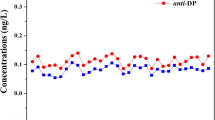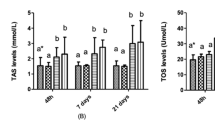Abstract
The kinetics of accumulation of pentachlorophenol (PCP) at various pH values were investigated to explore how pH-dependent accumulation might influence PCP toxicity. Goldfish (Carassius auratus) were exposed to 5 μg PCP/L in a static system buffered with 7.5 mM bicine orN,N-bis(2-hydroxyethyl)-2-aminoethane sulfonic acid (BES) at pH 7.0, 8.0, or 9.0. The amount of PCP in the fish, concentration of PCP in water, and the total amount of metabolites in the system were measured after exposure of fish from 1 to 96 hr. Equations for these variables based on a two compartment pharmacokinetic model were fitted simultaneously to the data using NONLIN, which uses an iterative nonlinear least squares technique. Uptake clearance, metabolic clearance, and apparent volume of distribution of PCP decreased as pH increased. The decrease in PCP accumulation with increased pH was not due solely to a pH-induced decrease in uptake. In addition, the distribution of PCP within the fish was altered by changes in the external pH. The pH-associated changes in distribution may have altered access of PCP to sites of metabolism, thereby altering the metabolic clearance. The pH-related changes in the pharmacokinetics of PCP resulted in a decrease in its bioconcentration factor with an increase in pH and account both for the decreased capacity of the fish to accumulate PCP and for its reduced LC50.
Similar content being viewed by others
References
Boxenbaum HG, Riegelman S, Elashoff RM (1974) Statistical estimates in pharmacokinetics. J Pharmacok Biopharm 2:123–148
Cirelli DP (1978) Patterns of pentachlorophenol usage in the United States of America—an overview. In Rao KR (ed) Pentachlorophenol, Environmental Science Research Series Vol. 12, Plenum Press, New York, pp 13–18
Collander R (1950) The distribution of organic compounds betweeniso-butanol and water. Acta Chemica Scand 4:1085–1098
Dalela RC, Rani S, Rani S, Verma SR (1980) Influence of pH on the toxicity of phenol and its two derivatives pentachlorophenol and dinitrophenol to some freshwater teleosts. Acta Hydrochim Hydrobiol 8:623–629
Dave G (1984) Effect of pH on pentachlorophenol toxicity to embryos and larvae of zebrafish (Brachydanio rerio). Bull Environ Contam Toxicol 33:621–630
Dively JL, Mudge JE, Neff WH, Anthony A (1977) Blood Po2, Pco2 and pH changes in brook trout (Salvalinus fontinalis) exposed to sublethal levels of acidity. Comp Biochem Physiol 57A:347–351
Erickson RJ, McKim JM (1987) Toxicokinetics of pentachlorophenol in rainbow trout. Presented at the Eight Annual Meeting of the Society of Environmental Toxicology and Chemistry. Pensacola, FL., November 9–12, 1987
Gibaldi M, Perrier D (1982) Pharmacokinetics, 2nd edition, Marcel Dekker, New York
Hayton WL, Stehly GR (1983) pH control of weak electrolyte toxicity to fish. Environ Toxicol Chem 2:325–328
Hayton WL, Barron MG (1990) Rate limiting barriers to xenobiotic uptake by the gill. Environ Toxicol Chem 9: (in press)
Kaiser KLE, Valdmanis I (1982) Apparent octanol/water partition coefficients of pentachlorophenol as a function of pH. Can J Chem 60:2104–2106
Karara AH, Hayton WL (1984) Pharmacokinetic model for the uptake and disposition of di-2-ethylhexyl phthalate in sheepshead minnowCyprinidon variegatus. Aquat Toxicol 5:181–195
Kobayashi K, Kishino T (1980) Studies on the metabolism of chlorophenols in fish. XIII. Effect of pH on the toxicity and accumulation of PCP in goldfish. Nippon Suisan Gakkaishi 46:167–170
Lo IH, Hayton WL (1981) Effects of pH on the accumulation of sulfonamides by fish. J Pharmacokinet Biopharm 9:443–459
McKim J, Schmieder P, Veith G (1985) Absorption dynamics of organic chemical transport across trout gills as related to octanolwater partition coefficient. Toxicol Appl Pharmacol 77:1–10
Metzler CM, Elfring GL, McEwen AJ (1974) A package of computer programs for pharmacokinetic modeling. Biometrics 30:562–563
Saarikoski J, Viluksela M (1981) Influence of pH on the toxicity of substituted phenols to fish. Arch Environ Contam Toxicol 10:747–753
— (1982) Relation between physicochemical properties of phenols and their toxicity and accumulation in fish. Ecotoxicol Environ Safety 6:501–512
Saarikoski J, Lindstrom R, Tyynela M, Viluksela M (1986) Factors affecting the absorption of phenolics and carboxylic acids in the guppy.Poecilia reticulata. Ecotoxicol Environ Safety 11:158–173
Schmeider PK, Henry PR (1988) Plasma binding ofn-butanol, phenol, nitrobenzene, and pentachlorophenol in trout and rat. Comp Biochem Physiol 91C:413–418
Sittig M (ed) (1980) Priority toxic pollutants: Health impacts and allowable limits. Noyes Data Corp, Park Ridge, NJ
Spehar RL, Nelson HP, Swanson MJ, and Renoos, JW (1985) Pentachlorophenol toxicity to amphipods and fathead minnows at different test pH values. Environ Toxicol Chem 4:389–397
Stehly GS, Hayton WL (1988) Detection of pentachlorophenol and its glucuronide and sulfate conjugates in fish bile and exposure water. J Environ Sci Health B23:355–366
— (1989) Disposition of pentachlorophenol in rainbow trout (Salmo gairdneri): Effect of inhibition of metabolism. Aquat Toxicol 14:131–148
US Environmental Protection Agency (1980) Ambient water quality criteria for pentachlorophenol. EPA 440/5-80-065. Office of Water Regulations and Standards, Washington, DC
Yakomota K, Nakagawa T, Uno T (1978) Application of Akaike's information criterion (AIC) in the evaluation of linear pharmacokinetic equations. J Pharmacol Biopharm 6:165–175
Author information
Authors and Affiliations
Rights and permissions
About this article
Cite this article
Stehly, G.R., Hayton, W.L. Effect of pH on the accumulation kinetics of pentachlorophenol in goldfish. Arch. Environ. Contam. Toxicol. 19, 464–470 (1990). https://doi.org/10.1007/BF01054993
Received:
Revised:
Issue Date:
DOI: https://doi.org/10.1007/BF01054993




